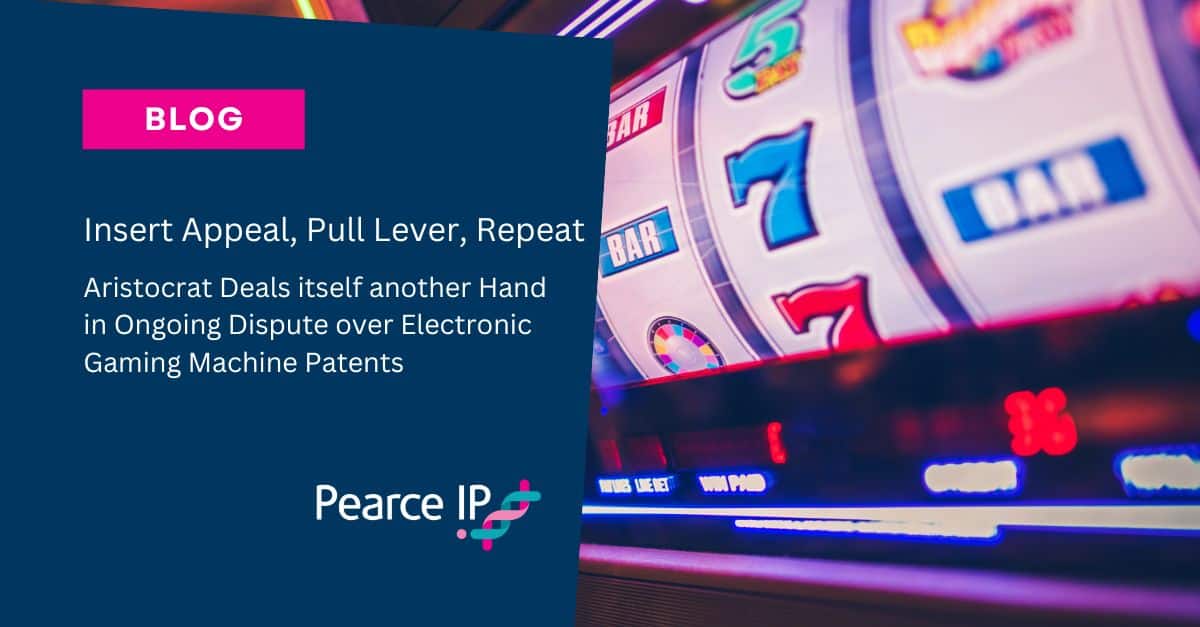| Date of decision: | 30 August 2024 |
| Body: | Federal Court of Australia |
| Adjudicator: | Justice O’Bryan |
In a recent Federal Court decision, Justice O’Bryan has granted Aristocrat Technology Australia Pty Ltd (Aristocrat) leave to appeal against Justice Burley’s decision on remittal from March 2024. This latest development adds another chapter to the long-running saga concerning the patentability of Aristocrat’s electronic gaming machine technology.
The case, which has already seen multiple hearings in the Federal Court, a Full Court appeal, and an equally divided High Court Decision, centres on whether Aristocrat’s innovation patents claim a manner of manufacture within the meaning of s 18(1A)(a) of the Patents Act 1990 (Cth) (the Act).
Background and Procedural History
The Commissioner of Patents initially revoked four of Aristocrat’s innovation patents, finding that the relevant claims were not to a manner of manufacture. These patents, all related to gaming systems and methods, were:
- AU2016101967 (967 patent)
- AU2017101097 (097 patent)
- AU2017101098 (098 patent)
- AU2017101629 (629 patent)
Aristocrat appealed to the Federal Court, where Justice Burley allowed the appeal, setting aside the Commissioner’s decision. The Commissioner then successfully appealed to the Full Court, which delivered two judgments (a joint and a separate judgment). Notably, the parties agreed that if claim 1 of the 967 patent is a manner of manufacture, then so too were the rest of the claims in all of the patents in suit. The Full Court ultimately found that claim 1 of the 967 patent was not a patentable invention.
Aristocrat’s subsequent appeal to the High Court resulted in a 3:3 split decision. As per s 23(2)(a) of the Judiciary Act 1903 (Cth) (Judiciary Act), this equally divided opinion affirmed the Full Court’s decision, remitting the proceedings back to the primary judge.
On remittal to the Federal Court, Justice Burley dismissed Aristocrat’s appeal from the original decision of the Commissioner, applying the Full Court’s reasoning to the residual claims.
Following this, Aristocrat sought leave to appeal under s 158(2) of the Act, raising two principal issues:
- Whether the primary judge erred in applying s 23(2)(a) of the Judiciary Act, specifically in applying the Full Court’s reasoning rather than the reasoning in the High Court’s split decision.
- Whether the primary judge ought to have found that the invention claimed in the residual claims is a manner of manufacture.
Parties’ Submissions
In seeking leave to appeal, Aristocrat presented three main arguments. Aristocrat contended that the primary judgment’s finality in determining their innovation patents’ non-grant could cause substantial injustice. Aristocrat also contended that their appeal grounds were arguable, pointing to the disagreement among High Court judges with parts of the Full Court’s reasoning (albeit three ultimately coming to the same conclusion). Lastly, Aristocrat emphasised the case’s broader significance for patent law administration and the patentability of computer-implemented inventions.
The Commissioner, opposing leave, countered that the primary judge’s decision was not sufficiently doubtful so as to warrant reconsideration, emphasising that the High Court’s split decision created no binding precedent. The Commissioner further argued that Aristocrat did not raise issues of general importance. The Commissioner also argued that refusing leave would not cause substantial injustice given the patents’ expiration and Aristocrat’s pending standard patent applications on the same subject matter.
Consideration
Justice O’Bryan noted that the application for leave was finely balanced. His Honour agreed that the primary judgment finally determined the non-grant of the patents in suit but observed that this consideration was lessened by:
- The parties’ agreement that the patentability of claim 1 of the 967 patent had been finally determined by the Full Court’s decision, and all that remained was determination of the residual claims by the primary judgment.
- The expiration of the innovation patents and Aristocrat’s pending standard patent applications covering the same subject matter which remained on foot.
His Honour accepted that Aristocrat’s grounds of appeal were arguable, noting the novel issues concerning the application of s 23(2)(a) of the Judiciary Act, especially in unusual circumstances where the affirmed Full Court decision required a remittal based on its own reasoning, despite both High Court judgments disagreeing with parts of that reasoning.
However, Justice O’Bryan was not fully convinced by Aristocrat’s argument about the wider significance of the case to patent law administration and the patentability of computer-implemented inventions, observing that the case’s unusual circumstances limited its broader applicability.
Despite reservations about granting what could be seen as a “second go” at establishing different principles for adjudicating the manner of manufacture requirement, Justice O’Bryan ultimately granted leave to appeal. Two factors marginally tipped the balance:
- The effect of the primary judgment in finally determining that the innovation patents would not be granted.
- The arguable nature of Aristocrat’s grounds of appeal, which raised novel questions about the operation of s 23(2)(a) of the Judiciary Act in unusual circumstances.
Key Takeaways
This decision prolongs the uncertainty surrounding the patentability of computer-implemented inventions in Australia and highlights the contrasting approaches taken at different court levels:
- Federal Court (Justice Burley): Initially found Aristocrat’s invention to be a manner of manufacture and not a mere scheme
- Full Court: Unanimously overturned this decision, emphasising the need for an advance in computer technology itself.
- High Court: Equally divided on the patentability of the Aristocrat gaming technology, but overall critical of the Full Court’s two-step test.
The case now raises novel questions about the application of s 23(2)(a) of the Judiciary Act in cases of equally divided High Court decisions. According to the currently accepted interpretation of s 23(2)(a) of the Judiciary Act, the Full Court’s approach stands as the prevailing test.
However, the Full Court’s approach remains contentious and may be subject to change. All eyes now turn to the Full Court and the opportunity it has to provide clarity as to the proper application of the Judiciary Act, and perhaps further to the patentability of computer-implemented inventions in light of the High Court’s reasoning.
About Pearce IP
Pearce IP is a specialist firm offering intellectual property specialist lawyers and attorneys with a focus on the life sciences industries. Pearce IP and its leaders are ranked in every notable legal directory for legal, patent and trade mark excellence, including: Chambers & Partners, Legal 500, IAM Patent 1000, IAM Strategy 300, MIP IP Stars, Doyles Guide, WTR 1000, Best Lawyers, WIPR Leaders, 5 Star IP Lawyers, among others.
In 2025, Pearce IP was recognised by Australasian Lawyer and New Zealand Lawyer’s 5 Star Employer of Choice, and is the “Standout Winner” for inclusion and culture for firms with less than 100 employees. Pearce IP was awarded “IP Team of the Year” by Lawyers Weekly at the 2021 Australian Law Awards. Pearce IP is recognised by Managing IP as the only leading ANZ IP firm with a female founder, and is certified by WEConnect International as women owned.

Naomi Pearce
CEO, Executive Lawyer (AU, NZ), Patent Attorney (AU, NZ) & Trade Mark Attorney (AU)
Naomi is the founder of Pearce IP, and is one of Australia’s leading IP practitioners. Naomi is a market leading, strategic, commercially astute, patent lawyer, patent attorney and trade mark attorney, with over 25 years’ experience, and a background in molecular biology/biochemistry. Ranked in virtually every notable legal directory, highly regarded by peers and clients, with a background in molecular biology, Naomi is renown for her successful and elegant IP/legal strategies.
Among other awards, Naomi is ranked in Chambers, IAM Patent 1000, IAM Strategy 300, is a MIP “Patent Star”, and is recognised as a WIPR Leader for patents and trade marks. Naomi is the 2023 Lawyers Weekly “IP Partner of the Year”, the 2022 Lexology client choice award recipient for Life Sciences, the 2022 Asia Pacific Women in Business Law “Patent Lawyer of the Year” and the 2021 Lawyers Weekly Women in Law SME “Partner of the Year”. Naomi is the founder of Pearce IP, which commenced in 2017 and won 2021 “IP Team of the Year” at the Australian Law Awards.

Helen Macpherson
Executive, Lawyer (Head of Litigation –Australia)
Helen is a highly regarded intellectual property specialist and industry leader with more than 25 years’ experience advising on patents, plant breeder’s rights, trade marks, copyright and confidential information. She is known for her expertise in complex, high-value patent matters and leverages her technical background in biochemistry and molecular biology to work across a wide range of technologies, including inorganic, organic, physical and process chemistry, biochemistry, biotechnology (including genetics, molecular biology and virology), and physics. Helen is an active member of the Intellectual Property Committee of the Law Council of Australia and the Intellectual Property Society of Australia and New Zealand.

Nathan Kan
Lawyer
Nathan is a lawyer specialising in life sciences, providing legal advice and litigation support across intellectual property and commercial disputes. He is passionate about the intersection of law and science, and during his time with the Science and Technology Law Association at the University of Melbourne, he helped lead events, workshops and publications across STEM fields including life sciences, AI and digital transformation.

